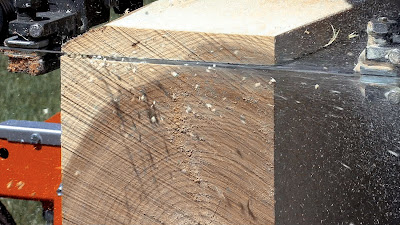Premature Sawmill Blade Breaks
Why do they happen and how can they be prevented? Look over these trouble-shooting tips to ensure that you are getting the most from your blades when using your own blade sharpener and setter.
1.
Running a blade dull or too long causes increased stress in the blade
- • Pull the blade at regular intervals to maximize flex life and lower material amount removed to get blade sharp again.
- • Change the blade immediately after striking a foreign object or material
- • Be sure to grind lightly and into the gullet to remove any stress cracks.
2.
Running a blade with damaged or worn blade guides can lead to failure
- • Replace roller guides when flat spots develop on the shell.
- • Replace roller guides when grooves develop in the flange or as flanges wear thin.
- • Replace roller guide or bearing if it will not spin freely or is loose.
- • Replace blade guide pads when fractured, worn thin or worn unevenly.
- • Blade guide pads should not be too tight and “heat” the blade. Be sure to adjust for different thickness of blades.
3.
Other sawmill conditions that can lead to blade breakage
- • Worn or cheap blade wheel belts.
- • Loose or damaged drive belts.
- • Insufficient blade tension or tension system problems.
- • Loose sliding arm that goes in and out.
- • Excessive build up on blade or blade wheel belts
- • Bearing failure in the blade wheels
- • Blade contacting any steel or guards while sawing.
4. ReSharpening issues that
can lead to premature blade failure
- • Grinding too heavy, burning the tooth and gullets.
- • Incomplete sharpening of total blade profile. Use a dye or nail polish to ensure getting it all.
- • Removing stress cracks forming in the gullet.
- • Missing the outside corners on the backside of set teeth.
- • Dress grinding wheel frequently to eliminate grazing and particles embedding into the wheel.
- • Dress the grinding appropriately for each profile or try CBN technology.
- • Maintain bend location when setting the blade and stay away from the tip.
5. Other factors that affect
blade life
- • Allowing blades to rust when storing.
- • Leaving sawdust and pitch buildup on teeth when storing blades. Flood the blade with lubrication before removing.
- • Remove blade tension when not using the mill.
- • Lubricate the blade while sawing.
- • Maintain proper tracking of the blade on blade wheels.
Use the Right Sawblade for the Job.
It is crucial to the success of the milling operation
to correctly match the right saw blade with the species and conditions of the
material being sawn. Thicker blades handle tougher sawing conditions but thinner
blades offer more flex life. Thicker blades also require more horsepower and
can saw faster! Some blade profiles also require more horsepower.
- The 7 degree and 4 degree blade are suited for higher horsepower machines in hardwoods and even softwoods.
- The 9 degree profile offers best performance on low horsepower, lower demanding and smaller logs.
- The 10 degree is the best all-around blade profile for mixed hardwoods and general sawing conditions.
- Don’t be afraid to try different profiles in your sawing conditions to see what works best for you.
Wood-Mizer's ReSharp is always available to meet your blade maintenance needs and make
it easier for you to experiment. You can even join our automatic blade replacement
program that gives you even more convenience and flexibility with your blade
supply. Visit http://www.woodmizer.com/us/Blades.aspx to learn more about blades, Wood-Mizer's ReSharp service, blade maintenance equipment, and the types of blades available from Wood-Mizer.


